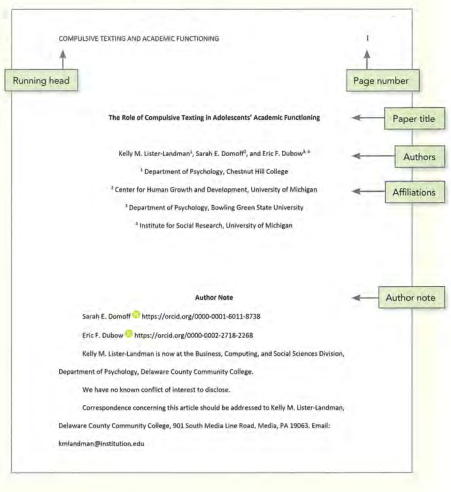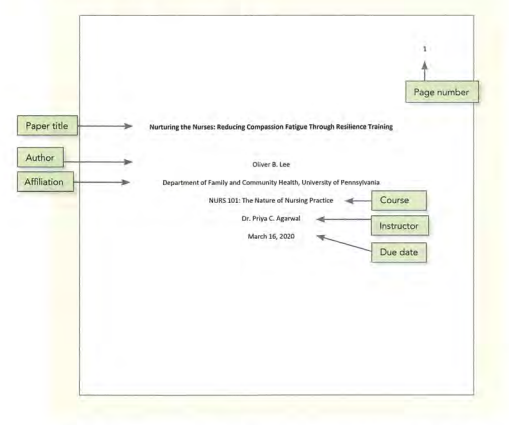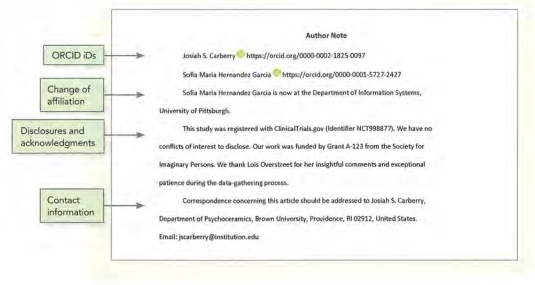APA Style Formats and Purpose of the Main Elements
APA styles offer a foundation for scholarly communication that is very effective. This is because it assists the authors in presenting their ideas in a clear, concise, and organized manner. Consistency makes it achievable for readers to keep more attention on the introduced ideas instead of scanning and formatting. Suggestions of various styles guide authors to discuss necessary details, which allows readers to pass with no distractions, which includes errors in reference citations, statistics and punctuation.
The main important component of an APA-style research paper is the subject, the topic, the author, the bond of the writer, the abstract, keywords, and the running title. The text may include an introduction, literature review, methods, results, findings, and discussion sections. Some papers may use a reference list, footnotes, and appendices as supplemental materials. There are two versions of the title pages, one for professionals and the other for students. The paper title, author name, author affiliation, the author notes, running head, and page number are included in a professional title page. Students are supposed to follow the instructions that their instructors give them on how their title page should look (APA, 2020). The title page for students should always have the title, author, affiliation of the student, the university being attended, course name and number, the instructor’s name, and the due date of the assignment.


The author’s name should be included in every paper, and the preferred format is the first name, initial(s) of the middle name, and last name to minimize the likelihood of mistaking an identity. The main objective of an author affiliation is to define where the author was studying at the time of research. The authors’ note is mainly for providing information like data sharing, denials and study registration. (APA, 2020). Author notes are not always included in the student papers in most cases. Running heads is the paper title in abbreviation appearing on top of each page to show the readers of the published article. Running heads are not needed for students’ papers unless the institution or the instructor requests it.

An abstract is a brief summary that is comprehensive of the contents included in the paper, and they are limited to 250 words as the maximum. It should mainly consist of original work, as no quotations are allowed. Keywords are the acronyms, phrases, or words that speak about the aspects of the paper that are most important. The keywords must always be utilized in indexing in the databases to assist the readers in finding the paper when researching. A given abstract must strictly be complete as well as give a detailed answer to a given question or topic to avoid any further reference from different sources. The text or the paper body has the author’s main contributions to the literature. The text may be arranged in different ways, and this arrangement relies on what style is being used. Most of the papers used always have an introduction that describes the paper’s importance and aim and contextualizes the literature on the work. A literature review builds familiarity by understanding the current research in a specific field before doing new research (APA, 2020). It enables a reader to know the already done research and identify which topic is to be discussed.
In a research paper, the methods sections offer information by which the study’s validity is charged. On the other hand, the results sections report the study’s findings based on the methodologies used in gathering the information. The findings section must always summarize notes of the study outcomes and explains the significant discoveries made. The discussion section describes analyses and then interprets the studies of given findings. A given trial must strictly start on a blank page after the abstract and the title page. This is if the paper includes an abstract. The reference list offers a reliable way for the readers to locate the works cited by the authors to acknowledge their previous scholarships. References are for substantiating and documenting statements made in the literature. References are written on a new page after the text, and they are double-spaced with a hanging indent (APA, 2020). Footnotes are brief notes that offer copyright attributions or additional content. Appendices have supplementary materials and offer a more comprehensive understanding of the research problem. Supplementary materials enhance the understanding and experience of the readers.
The format of the paper is the physical appearance of the paper and can detract or enhance a reader from the paper. The pages of the paper should be in this order: the title of the page, abstract, text, references, footnotes, tables, figures, and, lastly, appendices. All the pages should have page numbers flush right in the header, and the font should all be accessed by all the users to meet all the requirements of an APA Style. The whole paper should be double-spaced, and a margin on all sides should be 1-in. The text should be aligned to the left, the right margin should be left uneven, and all the first lines of every paragraph should have an indentation of 0.5.
APA Standards in Psychology
Apart from following the specific standards for publishing and writing, scholarly research authors should also abide by ethical standards. APA’s legal and ethical principles are designed to achieve writing goals (APA, 2020). These goals include making sure the scientific findings are accurate, protecting the rights and welfare of the research subjects and participants, and protecting intellectual property rights. Regardless of the article type, ethical concerns should be adhered to. The issues that should be considered carefully while researching in the planning stages are those related to informed consent, institutional approval, research deception, data sharing, and participant protection.
The importance of ethics in all scientific reports is to guide authors on the results and methods of their studies, which should be accurate. Data should not be falsified or fabricated, and results modification, including images to support a hypothesis or a theory and removing troublesome observations in a report, is prohibited. Preparation of manuscripts for publication that is very careful is always considered essential, but errors can be there in the article published as the final paper. When the errors become substantive enough to affect the readers’ understanding of the research or how they interpret the results, the authors have the responsibility of making those mistakes or errors public.
The authors of a paper are required to retain the data associated with the article published in accordance with the requirements of the institution, funder requirement, and agreements of participants and when publishing in the APA journal. The APA Ethics Code forbids authors from not sharing data from requesters that have the qualifications to verify via reanalysis in many cases. This is mainly when the participant’s confidentiality is safe and protected (APA, 2020). The reports in the literature review should correctly portray the various research initiatives’ independence. Both piecemeal and duplicate data publications misprint the amount of original research in the scientific knowledge repository. Duplicate publication is giving the same ideas or data in different papers. The piecemeal publication divides unnecessary findings from a single research effort into multiple different works.
Copying presents another author’s ideas, images, or words as one’s own, denying the author’s credit where credit is needed. Whether plagiarism is unintentional or deliberate, it violates the ethical standards in the scholarship and has profound real-world effects. Authors are restricted from sharing personal data considered confidential about students, patients, organizations, or another receiver of the services offered.
Publication Process
The APA style publication process in relation to the American Psychological Association focuses on the recommendations that should be included in a psychology research report. A writer has to be in an appropriate position to find the correct journal by adequately considering the journal’s aim, scope of work, and performance metrics. The importance of publishing in APA style is able to facilitate modern communication by encouraging transparency of systemic organization content and articles researched
APA style has been said to be of a ‘class ‘in article writing, which is usually considered important for presenting psychological research results. To be an excellent academic writer, an individual has to effectively adopt the most suitable style for the writing tasks at hand. It is essential to study the APA manuscript publication manual, which provides empirical research reports with distinct page elements that are written in the same order. It includes the title, which presents the article’s name, the author’s name, and affiliations, while the abstract summarizes the research article (APA, 2020). The introduction effectively describes the rationale and previous research for the recent study. Methods focus on how the research was carried out. Results describe the outcome of the research study and discussions that summarize the whole study and its implications.
In APA writing, there are few direct researcher quotations because the phenomena and psychological theories are usually objective and do not depend on any specific words. Most APA disapproval is always directed at other researchers’ articles. This is because the style focuses on conclusions about a particular plan but not the real nature of particular researchers. Research reports are always organized with specific sections aligned in a fixed order to provide a supreme approach to conducting empirical research writing in psychology.
As a result, many researchers tend to hedge their conclusions to the fact that scientific knowledge is tentative and always subject to any form of revision. A given conclusion should summarize the whole research report to enable the reader to clearly understand any topic discussed in the publication. The publication process is described in three distinct stages: the organization of a psychology research article and high-level formal writing styles that are always straightforward. These styles usually communicate different ideas by simply providing clarification of different ideas. The low-level writing styles that consist of grammar, references, and article formatting are set to minimize literary devices like irony, suspense, humor, and metaphors.
The high-level APA style avoids languages described as biased against different particular groups. The principles used in avoiding discriminatory language are relatively simple, like being sensitive to different levels by entirely avoiding offensive terms in psychological APA writing (American Psychological Association, 2019). The low-level style consists of specific publication guidelines, including spelling, references, grammar, numbers, and citations. Most common APA errors are based on a manuscript analysis usually submitted to a professional journal within six years.
The end of the APA-style publication in an article or book contains references to the works cited in a text. In APA writing, the reference list starts at its page with the heading’ references’ that has to be centered in lower and upper cases. These references should be listed alphabetically as per the author’s last name of the first name for each citation, and these references should include a hanging indent (APA, 2020). The first line of the indent should not be indented, but all the other subsequent lines should be indented. The authors’ names must appear in the same order as the article, indicating the author’s positive contribution to the research.
References
American Psychological Association. (2019). Publication Manual of the American Psychological Association, (2020) (p. 428). American Psychological Association.
American Psychological Association. (2019). Publication Manual of the American Psychological Association, (2020) (p. 428). American Psychological Association.
